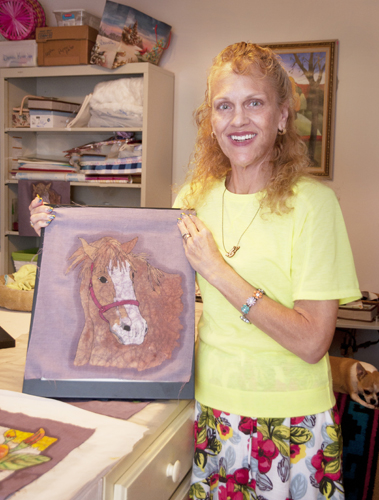
Sebastian artist Lori Kirkland’s joyful creativity covers a wide range of artistic media, from watercolor to wood carving, ceramics and pottery to oils.
When she visits her dad in Charleston, SC, she works with him in the back yard welding re-bar into garden art. At home in Sebastian, she presses large leaves into cement to form garden bowls which hold water for birds and butterflies. And, recently, her attention has turned to an interesting new take on the ages-old batik technique.
Born on the naval base at Newport, RI, Kirkland is “a Navy brat,” and traveled extensively with her family as her father, a Master Chief, received new assignments. Her love of art developed early as she explored new cultures and their art traditions. Living in Cuba, Bahrain, Saudi Arabia and other exotic places, she learned to love many kinds of artistic expression.
“I was always attracted to arts and crafts,” she says. “I first learned about shading from Paint-by-Numbers. I never took a real class until I moved to Sebastian and joined the art club.”
Kirkland has the luxury of having an entire room, in the home she shares with husband Ronald, transformed into a studio, dedicated to her artistic versatility. Shelves and cabinets line every wall; drawers are filled with paint, papers, brushes, bowls, pots, fabric and any number of odds and ends which, as the muse guides her, she’ll transform into a new creation.
“Whatever the project is, I’ll have what it takes to do it, somewhere in here,” she says as she gestures to the shelves and bins.
Kirkland is especially excited about the batik pieces she is creating, using a humble medium most people remember from kindergarten – Crayola crayons. “I said there’s got to be something I can do, something different, something that’s my own,” she says.
Casting about for an idea, she recalled an art class from her Palm Bay high school days, in which melted crayons were used to adapt and streamline the batik process.
The studio’s focal point is a sturdy table in the center, upon which sit boxes of crayons, jars of various-size nylon brushes and a large electric skillet. In the skillet is a big muffin tin, each cup containing a different color melted crayon.
Kirkland explains that the traditional batik process is multi-step: Paint is applied, then wax is applied and removed, then the process is repeated multiple times, based on the design and colors. “I thought ‘why go through all that?’ With crayons you have both the wax and the color.”
After Kirkland has created a design outline in black, often on a piece of cotton sheet, she heats the appropriate crayons to the temperature she has determined works best. Then “you have to work fast applying the color,” because the melted wax hardens quickly.
When the various colors have all been applied to the sheet, she places it in the freezer to harden the wax. When that is accomplished, she removes it and crumples it into a ball, as wrinkly as possible, creating numerous breaks and cracks in the wax.
Next she plops the crumpled sheet into a warm bath of black dye for about 15 minutes, sloshing it around occasionally. (She keeps a big bowl of the dye solution in the bathtub and reheats as necessary.) Removing the wax is the next step: the fabric is straightened out, placed between thick layers of newspaper and ironed with a hot iron, repeating this step until all the wax has been absorbed into the newspaper.
The result has a look much like that of the traditional batik. Her subjects are dogs, cats, horses and lots of flowers. Her flower batiks are especially striking.
Kirkland says she has learned much and made many good friends within the Sebastian Art Club. Everyone, she says, is friendly and helpful, eager to provide guidance or share ideas, and she is delighted to be the designated welcomer when the Club is open to visitors, from 11 a.m. to 3 p.m. on Tuesdays, Thursdays and most Saturdays.



